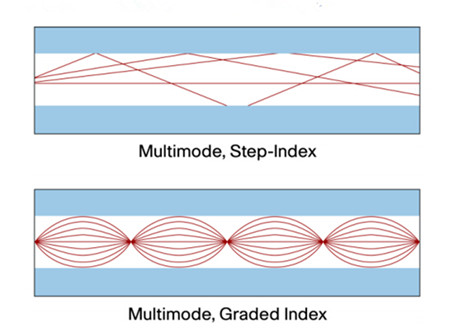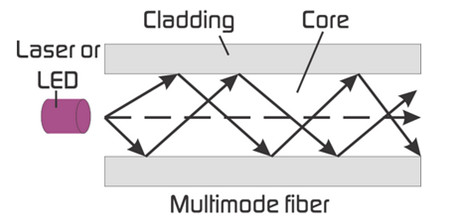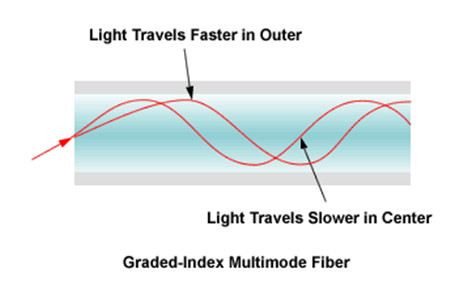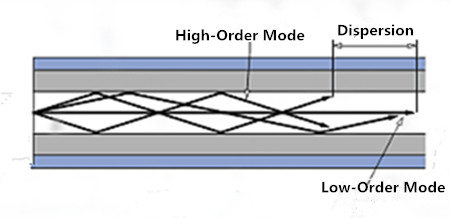Fiber optic cable is the media of telecommunications infrastructure, enabling the transmission of high-speed voice, video, and data traffic in enterprise and service provider networks. We usually see single mode and multimode optic fibers available on the market with distinct specifications utilized in different network infrastructure. Compared with single mode fiber patch cables, multimode fiber has a larger core diameters, allowing for the larger numbers of modes. Owing to this, multimode fibers can be categorized into step-index fiber and graded-index fiber seen in Figure 1. This article will describe the main characteristics of optical fiber in general, and the comparison between step index and graded index fibers in particular.

Quick Review of Fiber Optics
Before moving on to the topic, let’s have a quick view of the basics of fiber optics. Optical fiber is a flexible filament of very clear glass capable of carrying information in the form of light. It is roughly the diameter of a human hair, and may be many miles long. Light is transmitted along the center of the fiber from one end to the other, and a signal may be imposed. Fiber optic systems are superior to copper cables in many aspects, especially the bandwidth. Because of the wavelength of light, it is possible to transmit a signal that contains considerably more information than is possible with a copper cable.
A number of key parameters have impact on how optical fibers perform in transmission systems, of which attenuation and dispersion are the two important fiber parameters. Optical fiber comes in several different configurations, each ideally suited to a different use or application. The old used fiber designs like multimode and single mode are still used today. The following part will go on to talk about the details of multimode fibers.
Multimode Fiber
Multimode fiber has a larger core size of 50 to 62.5 microns than single mode fiber core of 9 microns, resulting in different modal distortion. As you can see in Figure 2, signal from one end is traveling in multiple beams from the LED or laser and it travels in different angles. Light in these modes follows paths that can be represented by light rays. The cladding glass has a refractive index—a parameter related to the dielectric constant, which is slightly lower than the refractive index of the core glass.

Furthermore, MM fiber patch cords experience greater attenuation, which make them better option for short distances, than for long ones. Multimode fiber is rarely available longer than couple km and is used to connect server to a network backbone. As noted before, multimode fiber may be divided into step-index and graded-index fiber.
Multimode Graded Index Fiber
Graded Index Fiber is a type of fiber where the refractive index of the core is lower toward the outside of the fiber. The core in a graded-index fiber has an index of refraction that radially decreases continuously from the center to the cladding interface. As a result, the light travels faster at the edge of the core than in the center as shown in Figure 3. Different modes travel in curved paths with nearly equal travel times. This greatly reduces modal dispersion in the fiber.

Graded-index fibers bends the rays inward and also allows them to travel faster in the lower index of refraction region. This type of fiber provides high bandwidth capabilities. As a result, graded-index fibers have bandwidths which are significantly greater than step-index fibers, but still much lower than single-mode fibers. Typical core diameters of graded-index fibers are 50, 62.5 and 100 µm. The main application for graded-index fibers is in medium-range communications, such as local area networks.
Multimode Step Index Fiber
Step Index Fiber is a fiber in which the core is of a uniform refractive index and there is a sharp decrease in the index of refraction at the cladding. The core of a step-index fiber has a uniform index of refraction right up to the cladding interface where the index changes in a step-like fashion. Because different modes in a step-index fiber travel different path lengths in their journey through the fiber, data transmission distances must be kept short to avoid considerable modal dispersion problems seen in Figure 4.

Step-index fibers are available with core diameters of 100 to 1500 µm. They are well suited to applications requiring high power densities, such as medical and industrial laser power delivery. Thus step-index fiber is barely used in current telecom and datacom applications.
Multimode Graded Index Fiber vs. Multimode Step Index Fiber
The main difference in step index and graded index fibers lies in the following points:
For step index fiber, the refractive index of the core is uniform and step or abrupt change in refractive index takes place at the interface of core and cladding in step index fibers. While for graded index fibers, he refractive index of core is non-uniform, the refractive index of core decreases parabolically from the axis of the fiber to its surface.
For step index fiber, the refractive index of the core is uniform and step or abrupt change in refractive index takes place at the interface of core and cladding in step index fibers. While for graded index fibers, he refractive index of core is non-uniform, the refractive index of core decreases parabolically from the axis of the fiber to its surface.
On the other hand, the light rays propagate in zig-zag manner inside the core of step index fiber. The rays travel in the fiber as meridional rays and they cross the fiber axis for every reflection, but the The light rays propagate in the form of skew rays or helical rays. They will not cross the graded index fiber axis.
Step-index multimode fiber was the first fiber design but is too slow for most uses, due to the dispersion caused by the different path lengths of the various modes. Therefore step-index fiber is barely used in current telecom and datacom applications. Graded-index multimode fiber uses variations in the composition of the glass in the core to compensate for the different path lengths of the modes. It offers hundreds of times more bandwidth than step index fiber.
Conclusion
Light can pass or propagate through fiber optic media as a single transmission path for single mode or for multimode fiber. Within the multimode fiber choices, the degree of refraction change between the core and the cladding varies between graded index and step index fibers. Compared with step index fibers, graded index fibers provides more bandwidth and are widely used in telecommunication field.
评论
发表评论